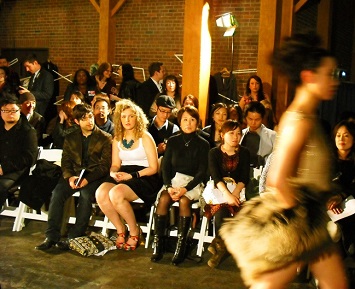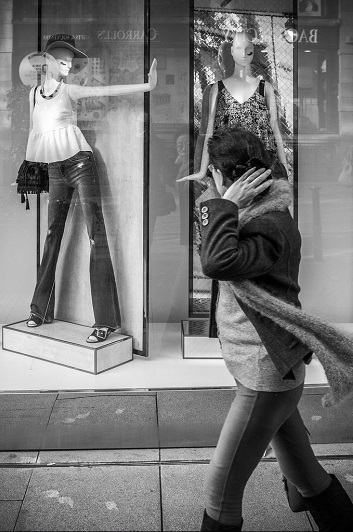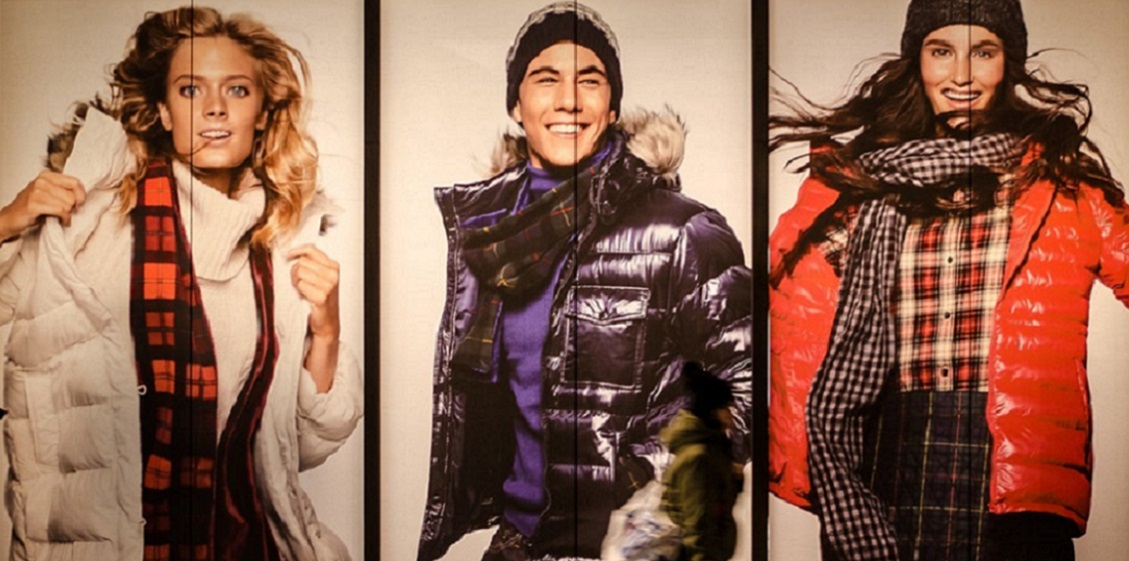One stroll around pretty much any modern day fast fashion store, and the scale of production and waste that comes hand in hand with our shared love of having the new ‘look’, is apparent. From the vast amount of waste made purely ‘in-house’, to its international reach, the modern fast fashion industry poses a number of problems for the health of our planet, and questions our treatment of the workers at the bottom of the production line. Will standards within the industry improve?
What’s In Our Clothes?
An obvious starting point with any analysis over the sustainability of our clothing is the materials they are made from. Polyester is the most popular fibre used for fashion, however the production and use of polyester fibres do considerable damage to the environment. For instance, when polyester garments are washed in domestic washing machines they shed microfibres that add to the increasing level of plastic in our oceans. These microfibres are minute and represent a serious threat to aquatic life.
Unfortunately, popular alternative fabrics also have their environmental downfalls. Nearly 40% of fast fashion clothing is manufactured out of cotton, which just so happens to be the thirstiest material crop requiring the largest percentage of chemicals: 25% of the world’s insecticides and 10% of the world’s pesticides. That spells an enormous amount of run-off and pollution for rivers and oceans. There is growing interest in organic cotton with some of the biggest brands, but overall use of organic cotton represents less than 1% of the world’s total annual cotton crop.
There is also an increased attention being paid towards the sustainability of leather production in the fast fashion industry. Conventional leather is heavily criticised for the environmental impact of the tanning process. The tanning process is used to alter the protein structure of the animal skin or hide, making it more durable and less susceptible to decomposition, and also possibly colouring it. Chrome tanning is currently the most popular kind of tanning in the global leather industry.
A consequence of the chrome tanning process means that the industry has been one of the most polluting industries, thanks to the huge amounts of liquid and solid wastes generated. The toxic wastewater can seep into the ground and affect soil and groundwater supplies. In general, the leather tanning process puts considerable pressure onto the environment because of the complex processes involved. In emerging economies, such as India, where efficient waste management systems are often lacking, the environmental impact is especially prevalent.
India, as well as other emerging economies like China, play a big role in this global supply chain as they are one of the leading countries producing bovine (cowhide leather). The leather market has been a major contributor the Indian economy as it employs a whopping 2.5 million people, most of whom are considerably less privileged.
The industry has had a positive effect on the local economy as it has provided these parts of society with jobs, but there are several negative issues. For example, the industry does not pay fair wages and is still found to be using child labour.
Originally, Chrome tanning was introduced as an alternative to vegetable tanning, which is a laborious and time-consuming process. However, more sustainably conscious production lines, and fashion companies are looking towards vegetable tanned leather once again. As the term suggests, vegetable tanned leather is treated with entirely natural and organic tannins. They are extracted from vegetables or trees and infused into the grain of the hide. Little electricity is used during the process, the leather is not treated with synthetic substances, and all waste from the process is recycled. Vegetable tanned leather is therefore the much preferred choice for sustainably conscious consumers. Unfortunately, this attention to care and the environment, comes at a cost, with most vegetable tanned leather costing far more than its chrome-tanned competitors.
Ethical Sourcing and Transparency
In recent years increased attention has also been focused on the conditions of many of the workers at the bottom of the supply chain. In Bangladesh alone, around 3.6 million people work in the clothing industry. Big fast fashion companies themselves argue that their factories help poorer countries develop financially, and provide secure jobs for less privileged communities. However, a number of serious accidents in Bangladesh have had many consumers and industry insiders questioning their business ethics.
Specifically, in April 2013, at least 1,135 people were killed and hundreds injured, when an eight storey building, housing five garment factories collapsed on the outskirts of Dhaka. The factories were found to have supplied to some of the worlds biggest fashion brands. The collapse of the Rana Plaza was the worst industrial accident in Bangladesh and the world’s most deadly industrial accident since 1984.
Author of ‘Overdressed: The Shockingly High Cost of Cheap Fashion’, Elizabeth Cline, argues in her book that the Rana Plaza disaster became a watershed moment, in revealing to the world how little fashion brands knew about where their products were being made.
“Their supply chains had gotten so large and out of hand their own control, they didn’t know”.
According to the Fashion Transparency Index report, published annually by the non profit organisation Fashion Revolution, global fashion brands have increased the overall social and environmental transparency of their sourcing practices by just 5% since 2017.
Attitudes and Emerging Models
Campaigners working for a change in industry standards and norms, encourage consumers who want to improve their own sustainability, should choose quality clothes and make them last as long as possible by learning to repair or rework them. Buying secondhand or vintage clothing, considering renting outfits rather than buying, and washing garments less often at lower temperatures in a full machine can all help.
Campaigners have also worked for a change at industry level. After the shocking incidents in Bangladesh, pressure has indeed mounted upon industry practitioners, and improved high street fashion models have begun to form. Notably, a new addition to the H&M fashion group, Arket has begun to expand since founding in 2017.
CEO of the company, Lars Axellson, recently elaborated in an interview with Fashion United, upon the brands focus on sustainability.
“Our focus is on durable and long lasting productions that can be used for many years. Sustainability has a high priority in the development of Arket and, of course, has gone into all processes – from the selection of our suppliers to the materials used.”
Arket’s use of materials and transparency exemplify much of this focus. For instance, the company exclusively uses organic or sustainably sourced cotton, and chrome free, vegetable tanned leather in its products.
The company also employs a Sustainability and Quality Control Officer in each store. I spoke with the Officer working at the branch in Lyngby, Copenhagen, Laura Marie Hensen.
“Each store works incredibly hard to make sure that the employees are trained and educated effectively, in line with the company’s overall sustainability ethos. That way, information regarding sourcing of materials and production line, is more readily available to customers and workers. Of course, we also work hard to recycle and reuse every day items, cutting down on plastics, and taking good care of our own clothes and materials.”
This is certainly an improved model for modern day fast fashion companies. However, it is indeed a long way from what is entirely necessary for the health and benefit of the world.
Undoubtedly, the improvement of industry standards does reflect increasing consumer consciousness towards sustainability. High street buyers must be the drivers of real change, making informed decisions over where and what they buy, and taking effective care over the clothes they own. Industry giants will follow, standards will progress, and the safety of the environment, and garment workers around the world, will improve.
![]()
Literature
Butler (2018) ‘Is fast fashion giving way to the sustainable wardrobe?’ The Guardian, Sat 29 Dec. 2018
‘Sustainable & Ethical Fashion: Counters to Fast Fashion and Why They Matter’ Sustainable & Ethical Fashion, Sustainable Jungle
Pavlova, V (2018) ‘Fast Fashion Ethics: Should Clothing E-Tailers Be More Transparent?’ Forbes
Reuters (2017) ‘Factbox: Major industrial accidents in Bangladesh in recent years’ Reuters.com – World News, July 4, 2017
Nittle N (2018) ‘What the Rana Plaza Disaster Changed About Worker Safety’ Racked, April 13, 2018
Cline, E L (2013) ‘Overdressed: The Shockingly High Cost of Cheap Fashion’ Portfolio
‘What is Vegetable-tanned Leather’ Best Leather, Leather 101 Article Series
Bertazzo M et. al (2011) ‘Chrome-free leather, tanned with oxazolidine’ Research Gate
Choudhary A (2017) ‘What is Sustainable Leather?’ Wageningen University – Department of Social Sciences
‘Sustainable Leather’, Sustain Your Style
Wolf G, et al. (2014) ‘Leather and Sustainability: From Contradiction to Value Creation’ World Leather, Technology







